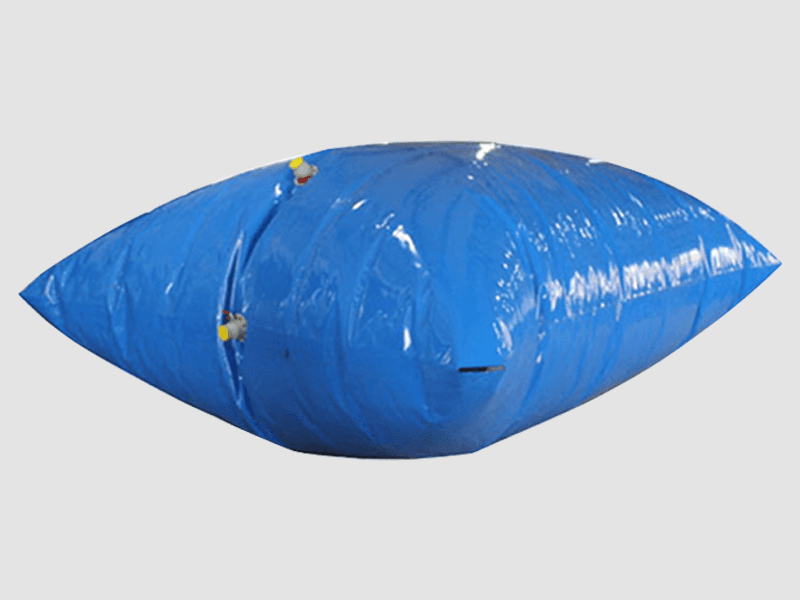The performance of PVC pillow water tank in terms of earthquake resistance and pressure resistance is mainly affected by its material properties and structural design. Compared with traditional steel and concrete water tanks, PVC water tanks have different performances in earthquake resistance and pressure resistance. The following is a detailed analysis of the characteristics and performance of PVC pillow water tanks in these two aspects from multiple aspects.
Earthquake resistance refers to the stability and safety of the water tank under vibration or impact such as earthquakes. Due to its strong flexibility, PVC pillow water tanks have certain earthquake resistance advantages in some aspects, but there are also certain limitations:
PVC, as a plastic material, has good flexibility and elasticity. During earthquakes or vibrations, the structure of the water tank can adapt to certain displacements or deformations, which helps to reduce the destructive power of vibrations on the water tank. Compared with rigid materials (such as steel, cement, etc.), PVC water tanks are more likely to resist the pressure of vibrations through flexible deformation during earthquakes.
Due to the strong plasticity of PVC, the water tank structure is not easy to crack when it is vibrated, which makes the PVC water tank more resistant to cracks during earthquakes and can effectively avoid the cracks or damage of traditional rigid water tanks during vibrations.
However, the earthquake resistance of PVC water tanks is not impeccable, especially for strong earthquakes with large vibration amplitudes or in the epicenter area, the structure of PVC water tanks may be affected to a certain extent. If the water tank does not have a suitable support or installation environment, it is still possible to tilt or be damaged under strong vibration.
In addition, the earthquake resistance of PVC water tanks also depends to a large extent on their installation method. Correct installation, solid foundation support and appropriate earthquake-resistant accessories (such as earthquake-resistant pads, reinforcement brackets, etc.) can significantly improve the earthquake resistance of water tanks. Therefore, in earthquake-prone areas, special consideration should be given to how to increase the stability of water tanks during design.
Pressure resistance refers to the ability of a water tank to withstand external pressure such as water or liquid, especially when the water tank stores a large amount of water, the impact of pressure is particularly significant. The pressure resistance of PVC pillow water tanks is mainly affected by the following factors:

The strength of PVC material itself is low, and its compressive strength is relatively weak compared to steel water tanks and concrete water tanks. When the water tank stores a large amount of liquid, the outside of the PVC water tank will be under certain pressure. If the structural design of the water tank is unreasonable or the material thickness is insufficient, it may deform, expand or even rupture under high pressure.
The design of PVC pillow water tanks usually adopts a pillow shape, which makes the force distribution of the water tank more uniform and helps to reduce the situation of excessive local pressure. The bottom of the pillow water tank usually bears greater pressure than the wall, so the bottom support needs to be strengthened during design to prevent the bottom of the water tank from deforming due to excessive pressure.
In the case of large-capacity water storage, the water pressure on the water tank will be greater, especially when the water depth increases, the bottom and side walls of the water tank need to withstand higher pressure. PVC material is lighter, but relatively speaking, its pressure resistance is not as good as steel or concrete water tanks. If the water storage volume is very large, PVC water tanks may need to use thicker materials or reinforced designs.
Generally speaking, PVC pillow water tanks are suitable for lower pressure environments, such as homes, agricultural irrigation, water storage and other occasions. For large reservoirs, industrial water and other places that need to withstand higher pressure or need to withstand pressure for a long time, traditional steel or concrete water tanks may have more advantages.
PVC pillow water tanks have certain seismic advantages in vibration environments such as earthquakes, mainly due to their good flexibility and elasticity. However, its earthquake resistance depends on the installation design and the structure of the water tank. Excessive vibration may affect the stability of the water tank. Appropriate support and reinforcement measures can effectively improve the earthquake resistance of the water tank.
The pressure resistance of PVC water tanks is relatively weak, especially when the water storage volume is large and the pressure is high, the PVC material may deform or crack. When it is suitable for low-pressure environments, PVC water tanks can play a good role, but for high-pressure requirements, it may be necessary to choose higher-strength materials or stronger structural designs.
PVC pillow water tanks have certain advantages in earthquake resistance and pressure resistance, especially in small water storage and low-pressure applications. However, in special environments such as large-scale, high-pressure, and strong earthquakes, its limitations still need to be considered, and corresponding optimization and reinforcement should be made during the design and use process.


 English
English русский
русский Français
Français Español
Español




















